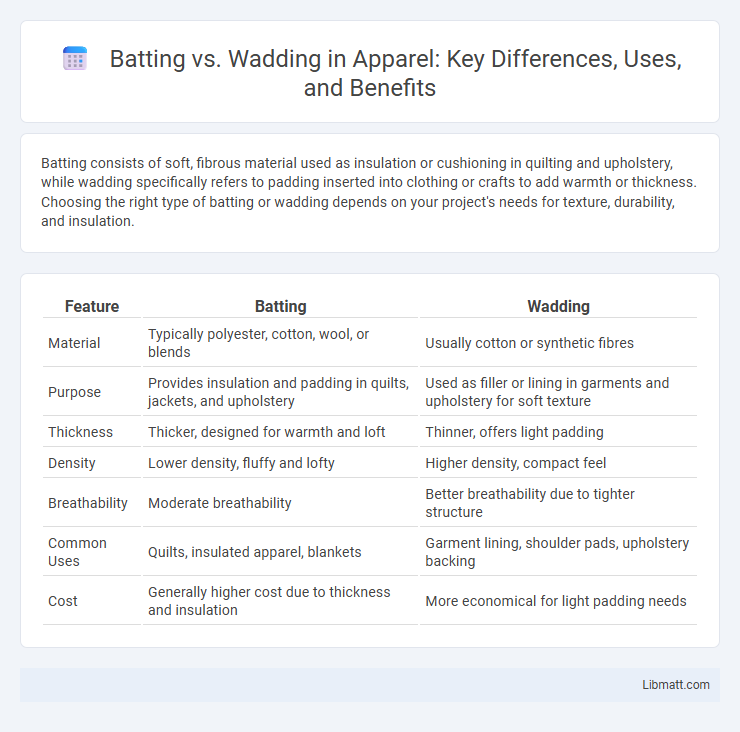Batting consists of soft, fibrous material used as insulation or cushioning in quilting and upholstery, while wadding specifically refers to padding inserted into clothing or crafts to add warmth or thickness. Choosing the right type of batting or wadding depends on your project's needs for texture, durability, and insulation.
Table of Comparison
| Feature | Batting | Wadding |
|---|---|---|
| Material | Typically polyester, cotton, wool, or blends | Usually cotton or synthetic fibres |
| Purpose | Provides insulation and padding in quilts, jackets, and upholstery | Used as filler or lining in garments and upholstery for soft texture |
| Thickness | Thicker, designed for warmth and loft | Thinner, offers light padding |
| Density | Lower density, fluffy and lofty | Higher density, compact feel |
| Breathability | Moderate breathability | Better breathability due to tighter structure |
| Common Uses | Quilts, insulated apparel, blankets | Garment lining, shoulder pads, upholstery backing |
| Cost | Generally higher cost due to thickness and insulation | More economical for light padding needs |
Understanding Batting and Wadding: Definitions and Differences
Batting is a soft, fibrous material used as insulation or padding in quilting and upholstery, typically made from cotton, polyester, or wool. Wadding refers to thicker, often denser stuffing material used to provide cushioning in mattresses, upholstery, and padded fabrics, commonly composed of cotton, felt, or synthetic fibers. The key difference lies in their density and purpose: batting offers lightweight insulation and shape, while wadding provides bulk and added cushioning.
Historical Background: The Origins of Batting and Wadding
Batting and wadding both trace their origins to early textile and upholstery practices, with batting initially developed from natural fibers like cotton and wool used for insulation and cushioning in quilts and garments. Wadding emerged as a softer, loosely woven material primarily utilized in padding and protective clothing, dating back to medieval Europe where it served as armor cushioning. Your understanding of these materials is enriched by their evolution from practical, handcrafted elements to essential components in modern textiles and upholstery.
Common Materials Used in Batting and Wadding
Batting commonly consists of cotton, polyester, wool, or blends designed for insulation and cushioning in quilting and upholstery. Wadding often uses similar materials but leans more towards polyester and recycled fibers to provide padding and moisture absorption in packaging and protective gear. Your choice between batting and wadding depends on the specific material properties needed for durability, softness, and support in your project.
Batting vs Wadding: Applications in Sewing and Quilting
Batting and wadding serve distinct purposes in sewing and quilting, with batting providing insulation and loft for warmth and texture, while wadding offers cushioning and structural support. Batting is typically made from cotton, polyester, wool, or blends, making it ideal for quilts, jackets, and blankets, whereas wadding is often used in upholstery, cushions, and padded garments to add softness without bulk. When choosing materials for your project, consider batting for thermal retention and wadding for padding and shape enhancement.
Insulation Properties: Warmth, Weight, and Breathability
Batting provides superior warmth due to its dense fiber composition, making it ideal for insulated quilts and winter garments, while wadding tends to be lighter and less insulating, suitable for lightweight projects. Batting's insulation properties balance warmth with breathability by trapping heat and allowing moisture vapor to escape, preventing overheating. Wadding typically offers less thermal weight but enhances breathability and flexibility, making it preferable for spring or fall wear where moderate insulation is desired.
Durability and Longevity Comparison
Batting is generally more durable than wadding because it withstands frequent use and repeated washing without losing its structural integrity. Wadding tends to compress and break down faster over time, resulting in reduced effectiveness for insulation or cushioning. Choosing high-quality batting ensures longer longevity, maintaining shape and performance in quilting and upholstery projects.
Ease of Use: Cutting, Shaping, and Stitching
Batting is generally easier to cut and shape due to its uniform, fluffy texture that conforms well to various patterns, making it ideal for quilting and craft projects. Wadding, being denser and stiffer, can be more challenging to manipulate but provides firmer support and structure when stitched, especially in upholstery or heavy-duty sewing. Your choice depends on the desired finish and ease of handling during cutting, shaping, and stitching tasks.
Care and Maintenance for Batting and Wadding Products
Proper care and maintenance of batting and wadding products extend their lifespan and maintain their performance. Batting should be gently cleaned and thoroughly dried to prevent mildew and clumping, while wadding requires careful handling to preserve its loft and insulating properties. Your attention to appropriate storage conditions, such as keeping these materials in a cool, dry place free from compression, ensures optimal functionality for future projects.
Cost Considerations: Budgeting for Batting vs Wadding
Batting generally costs more than wadding due to its higher quality materials and durability, making it a preferred choice for long-term sewing projects and quilting. Wadding is more affordable, often used for lightweight projects or temporary padding, offering a cost-effective solution for budget-conscious crafters. Evaluating project requirements and desired longevity helps determine the most economical choice between batting and wadding.
Choosing the Right Option: Factors for Selecting Batting or Wadding
Choosing between batting and wadding depends on your project's insulation, cushioning, and loft requirements. Batting, typically made from cotton, polyester, or wool, offers loft and warmth ideal for quilting and padding, while wadding provides denser cushioning and structure for upholstery or heavy-duty applications. Consider fiber content, thickness, and desired durability to select the best material for your specific needs.
Batting vs Wadding Infographic

 libmatt.com
libmatt.com